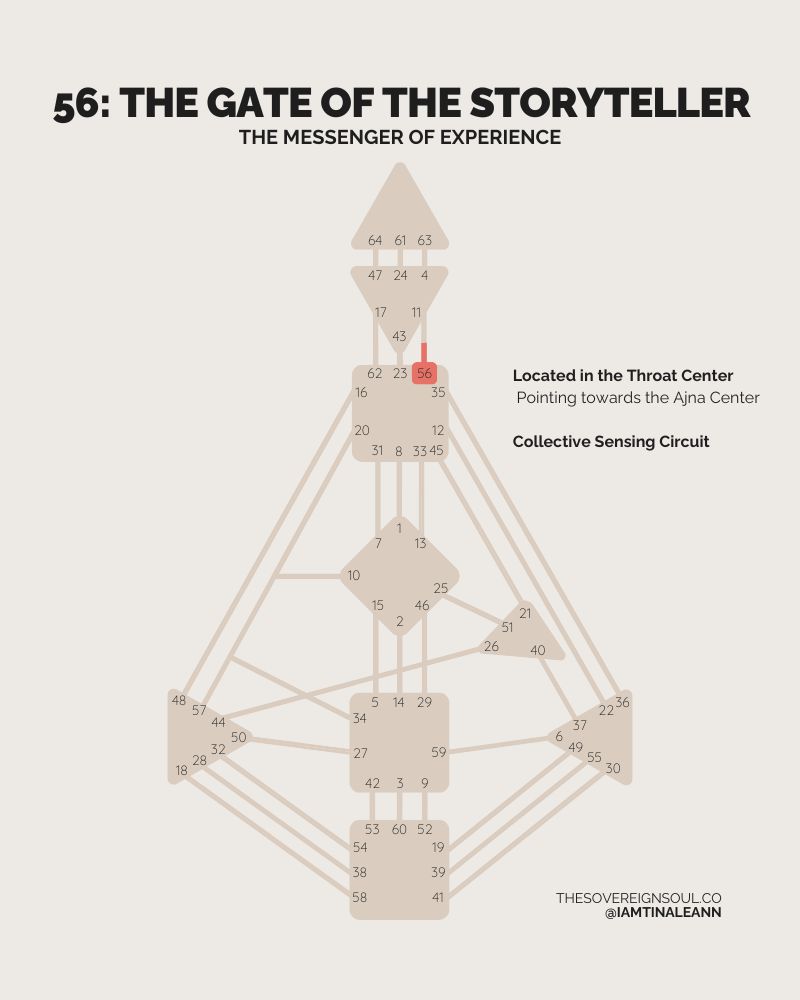Gate 56 in Human Design: The Gate of Storytelling – The Messenger of Experience
Do you love sharing stories, ideas, and experiences that inspire others? Are you someone who naturally turns life lessons into engaging conversations? Do you find that people are drawn to your words when you speak from the heart?
If so, you might be experiencing the energy of Gate 56 – The Gate of Storytelling in Human Design.
This gate is all about taking information, experiences, and ideas and turning them into meaningful narratives. It has a gift for weaving wisdom into words, making concepts easier to understand and more engaging. However, its biggest challenge is knowing when to speak and ensuring the message carries depth rather than just filling space with words.
Let’s explore the expressive, inspiring, and wisdom-sharing energy of Gate 56.
What is Gate 56 in Human Design?
Gate 56 is located in the Throat Center, which governs communication, manifestation, and self-expression.
This gate is part of the 11-56 Channel (The Channel of Curiosity) when connected to Gate 11 (The Gate of Ideas) in the Ajna Center. Together, these gates create a powerful ability to explore new perspectives, gather insights, and then communicate them in engaging ways.
Key Themes of Gate 56:
✅ A natural gift for storytelling – Turning experiences into wisdom.
✅ The ability to communicate in an engaging way – Captivating others with words.
✅ A thirst for adventure and learning – Seeking experiences to share.
✅ The challenge of depth vs. distraction – Ensuring words have meaning, not just entertainment.
Gate 56 is part of the Collective Sensing Circuit, meaning its energy is designed to share knowledge, perspectives, and inspiration with the collective rather than keeping insights to itself.
The Energy of Gate 56: The Power of Words & Stories
1. The Gift of Engaging Communication
Gate 56 has a unique ability to take complex experiences and make them relatable.
People with this energy often:
🔹 Have a talent for speaking, writing, teaching, or performing.
🔹 Feel drawn to travel, new experiences, and cultural exploration.
🔹 Love sharing insights in a way that inspires and educates others.
🔹 Remember details and emotions of experiences vividly, making storytelling powerful.
✨ Ask yourself: Am I using my voice to share wisdom and meaning, or am I just talking to fill the silence?
2. The Messenger, Not the Creator of Experiences
One unique aspect of Gate 56 is that it isn’t necessarily here to create new things—it’s here to communicate them.
🔥 It doesn’t need to invent—just to observe, experience, and then share.
🔥 It can take any topic and make it engaging and thought-provoking.
🔥 It thrives on new experiences and learning so it always has something to share.
This makes Gate 56 energy highly adaptable—it can talk about anything and make it interesting.
✨ Ask yourself: Am I gathering experiences that enrich my storytelling, or am I just recycling the same ideas?
3. The Challenge of Meaningful vs. Shallow Expression
Because Gate 56 is a highly verbal energy, it can sometimes lead to:
❌ Talking without depth – Words without real wisdom or purpose.
❌ Jumping from topic to topic – Lacking focus or direction in communication.
❌ Being misunderstood – Others may not always grasp the deeper meaning.
❌ Speaking too much instead of listening – Forgetting to engage in true dialogue.
💡 The key to mastering Gate 56 is balancing engaging expression with meaningful content—stories should inspire, not just entertain.
✨ Ask yourself: Am I speaking with intention and purpose, or am I just filling space with words?
How to Work with Gate 56 Energy
💡 Use Your Gift of Expression to Inspire – Your ability to tell stories can teach, motivate, and bring new perspectives to others.
💡 Choose Experiences That Enrich Your Voice – Travel, learning, and deep conversations help you gather material for storytelling.
💡 Be Mindful of When You Speak – Words have more impact when they are shared at the right time and with the right audience.
💡 Practice Deep Listening – Sometimes, wisdom comes from absorbing stories before telling them.
💡 Write, Speak, and Share Creatively – Podcasts, writing, public speaking, and coaching can help channel your energy into meaningful impact.
Final Thoughts: The Gift of Gate 56
Gate 56 carries the energy of storytelling, wisdom, and inspiration. It teaches us that:
✅ Words have power—use them wisely.
✅ Stories shape the world—share what matters.
✅ Experiences are meant to be passed on—your voice can transform perspectives.
✅ The right message at the right time can change everything.
If you have this gate, your ability to communicate and inspire through words is a gift. Honor your voice, choose your stories wisely, and know that what you say has the power to shape minds and hearts.
So, the question is: Are you using your voice to inspire, or are you just talking without purpose?
Feeling this energy? Drop a comment and share how Gate 56 shows up in your life!








